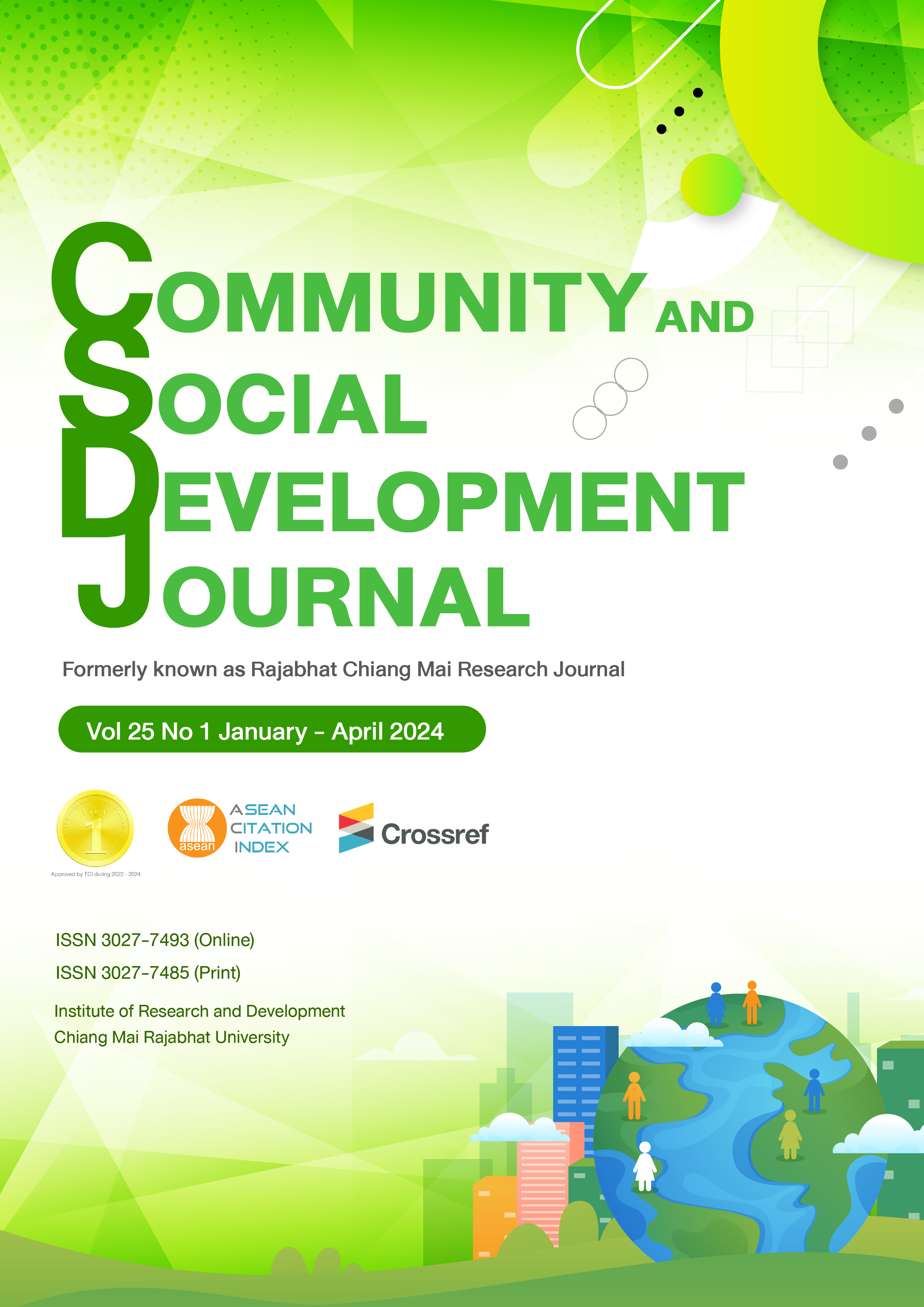Cyberbullying among Children and Youth in Thailand and Measures to Combat It
DOI:
https://doi.org/10.57260/rcmrj.2024.266344Keywords:
Cyberbullying, Measures, Online harassment, Online safetyAbstract
The incidence of cyberbullying among Thai youth has increased recently. Some situations may become severe and challenging to resolve. Consequently, the purpose of this study is to develop regulatory measures that protect young people from cyberbullying, with a focus on integrating collaboration throughout research and development (R&D). Participating in the study were elementary and secondary school students, as well as their families, educators, and experts, in addition to a group of stakeholders from educational institutions, law enforcement departments, and relevant government and civil society organizations. The findings revealed that cyberbullying among children and young people is widespread and takes many different forms. The circumstances related to cyberbullying arise from a youth's lack of understanding of the consequences of bullying, as well as their familial background and social environment. The measures developed to protect youth from cyberbullying included regulatory measures for schools (developing teachers, encouraging students, gaining access to the family, surveillance, and caring) and legal measures (modernizing the law, promoting legal literacy, and protecting youth). Focus should be placed on all levels, including the policy and operational levels. While expanding the study's results, it should be implemented in an approach that integrates with routine duties and operates network-connectedly in order to prevent and solve problems continuously and sustainably.
Downloads
References
Amaraphiban, A. (2016). Victims of cyberbullying among youth: risk factors, impact on mental health and third-party counseling. Research Science and Cognitive Science, 14(1), 59 – 73. Retrieved from https://ojs.lib.buu.ac.th/index.php/search2/article/view/4395
Barlett, P. (2017). From Theory to Practice: Cyberbullying Theory and Its Application to Intervention. Computers in Human Behavior, 72, 269-275. DOI:10.1016/j.chb.2017.02.060
Cohen, L., & Felson, M. (1979). Social Change and Crime Rate Trends: a Routine Activity Approach. American Sociological Review. 44, 488 - 608. DOI:10.2307/2094589
Daopradab, P. (2017). Patterns and characteristics of participation in online public bullying. (Master of Journalis,. Thammasat University.)
Dechamanee, O., Phusanam, A., & Chuaygarut, C. (2020). Forms, impacts and methods of managing cyberbullying. The 7th NEU National Conference 2020. Khon Kaen: Northeastern University.
Espelage, L., Rao, A., & Craven, G. (2013). Theories of Cyberbullying. Retrieved from https://www.researchgate.net/ publication/263090374
Gabrielli, S., Rizzi, S., Carbone, S., & Piras, E. M. (2021). School Interventions for Bullying–Cyberbullying Prevention in Adolescents: Insights from the UPRIGHT and CREEP Projects. Int. J. Environ. Res. Public Health., 18(21), 11697. DOI:10.3390/ijerph182111697
Gou, S., Liu, J., & Wang, J. (2021). Cyberbullying roles among adolescents: a social-ecological theory perspective. J. Sch. Violence, 20(2), 167-181. DOI:10.1080/15388220.2020.1862674
Inthanon, S. (2020). Cyberbullying. Bangkok: Foundation for the Promotion of Media for Children and Youth (ThaiHealth).
Kowalski, R., Giumetti, G., Schroeder, N., & Lattanner, R. (2014). Bullying in the digital age: a critical review and meta-analysis of cyberbullying research among youth. Psychol. Bull., 140(4), 1073-1137. Retrieved from https://doi.org/10.1037/a0035618
Naksiharat, D. (2018). Attitudes and legal problems related to the prevention and control of cyberbullying in Thailand. A case study of students in Mahasarakham University. CMU, Journal of Law and Social Science, 12(1), 135-171.
Papatthe, C., & Phuphet, N. (2019). Synthesis of Caused, Consequences, Preventions and Problem Solving of Cyber Bullying among Thai Adolescents [Paper Presentation]. Rajamangala University of Technology National Conference, the 11st: The Rajamangala Approach to Driving Innovation in the Economy and Society, Bangkok, Thailand.
Patchin, J. W., & Hinduja, S. (2011). Traditional and nontraditional bullying among youth: A test of general strain theory. Youth & Society, 43(2), 727-751. DOI:10.1177/0044118X10366951
Prachachat online. (2018). ICT Launches Cyberbullying Research Thai youth and the risk in the 4.0 era. Retrieved from https://www.prachachat.net/ict/news-146408
Saengsuwan, T. (2018). The role of the network in community energy management: a case study of Singburi renewable energy group. (Master’s thesis, National Institute of Development Administration).
Securly. (2018). The 10 Types of Cyberbullying. Retrived from https://blog.securly.com/2018/10/04/the-10-types-of-cyberbullying/
Strom, Paris S., & Strom, R. D. (2005). Cyberbullying by Adolescents: A Preliminary Assessment. The Educational Forum, 70(1), 21-31. DOI:10.1080/00131720508984869
Suwanakij, M. (2017). Legal measures to protect children and youth from being distilled. Bullying in social media. Jurisprudence journal Naresuan University, 10(2), 49 – 70. Retrieved from https://so04.tci-thaijo.org/index.php/lawnujournal/article/view/106267
Su, Y., Doty, J., Polley, BR., Cakmakci, H., Swank, J., & Sickels, A. (2021). Collaborating with Families to Address Cyberbullying: Exploring School Counselors’ Lived Experiences. Professional School Counseling. Retrieved from https://doi.org/10.1177/2156759X211053825
Swearer, S., Peugh, J., Espelage, D., Siebecker, A., Kingsbury, W., & Bevins, K. (2006). A social-ecological model for bullying prevention and intervention in early adolescence. Handbook of School Violence and School Safety: From Research to Practice. 257-273.
Tutkua, T., & Sabaiying, M. (2017). Patterns, impacts, and methods of dealing with cyberbullying of a college student in the south of Thailand". Journal of Behavioral Science for Development, 9(2), 220 – 236. Retrieved from https://so02.tci-thaijo.org/index.php/JBSD/article/view/82299
Tutkua, T., Laeheem, K., & Sittichai, R. (2019). Guidelines for preventing cyber-bullying behavior of high school students in the three southern border provinces. Journal of Behavioral Science for Developmen, 11(1), 91 – 106. Retrieved from https://so02.tci-thaijo.org/index.php/JBSD/article/view/149878
UNICEF. (2021). Cyberbullying: What is it and how to stop it. Retrieved from http://www.unicef. org/end-violence/how-to-stop-cyberbullying.
Yuwakoson, S. (2023). Empathy and communication skills are required to ensure that the digital world is not harmful. College of Social Communication Innovation, Srinakharinwirot University. Retrieved from http://cosci.swu.ac.th/news-event/cas/2023/
Downloads
Published
How to Cite
Issue
Section
License
Copyright (c) 2024 Rajabhat Chiang Mai Research Journal

This work is licensed under a Creative Commons Attribution-NonCommercial-NoDerivatives 4.0 International License.
1. Articles, information, content, images, etc published in the “Community and Social Development Journal” are copyrighted by the Community and Social Development Journal, Chiang Mai Rajabhat University. In order to properly distribute the articles through print and electronic media, the authors still hold the copyright for the published articles under the Creative Commons Attribution (CC BY) license, which allows the re-distribution of the articles in other sources. References must be made to the articles in the journal. The authors are responsible for requesting permission to reproduce copyrighted content from other sources.
2. The content of the articles appearing in the journal is the direct responsibility of the article authors. The editorial board of the journal does not necessarily agree with or share any responsibility.














